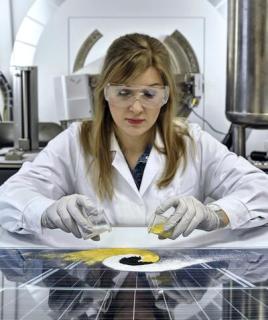Jan 18 2016
Perovskites, substances that perfectly absorb light, are the future of solar energy. The opportunity for their rapid dissemination has just increased thanks to a cheap and environmentally safe method of production of these materials, developed by chemists from Warsaw, Poland.
 A simple, fast and safe method of obtaining perovskites has been discovered by scientists from IPC PAS in Warsaw, Poland. The perovskite (a black powder) is milled from two powders: a white one, methylammonium iodide, and a yellow one, lead iodide. Credit: IPC PAS, Grzegorz Krzyzewski
A simple, fast and safe method of obtaining perovskites has been discovered by scientists from IPC PAS in Warsaw, Poland. The perovskite (a black powder) is milled from two powders: a white one, methylammonium iodide, and a yellow one, lead iodide. Credit: IPC PAS, Grzegorz Krzyzewski
Rather than in solutions at a high temperature, perovskites can now be synthesized by solid-state mechanochemical processes: by grinding powders.
We associate the milling of chemicals less often with progress than with old-fashioned pharmacies and their inherent attributes: the pestle and mortar. It's time to change this! Recent research findings show that by the use of mechanical force, effective chemical transformations take place in solid state. Mechanochemical reactions have been under investigation for many years by the teams of Prof. Janusz Lewinski from the Institute of Physical Chemistry of the Polish Academy of Sciences (IPC PAS) and the Faculty of Chemistry of Warsaw University of Technology. In their latest publication, the Warsaw researchers describe a surprisingly simple and effective method of obtaining perovskites - futuristic photovoltaic materials with a spatially complex crystal structure.
"With the aid of mechanochemistry we are able to synthesize a variety of hybrid inorganic-organic functional materials with a potentially great significance for the energy sector. Our youngest 'offspring' are high quality perovskites. These compounds can be used to produce thin light-sensitive layers for high efficiency solar cells," says Prof. Lewinski.
Perovskites are a large group of materials, characterized by a defined spatial crystalline structure. In nature, the perovskite naturally occurring as a mineral is calcium titanium(IV) oxide CaTiO3. Here the calcium atoms are arranged in the corners of the cube, in the middle of each wall there is an oxygen atom and at the centre of the cube lies a titanium atom. In other types of perovskite the same crystalline structure can be constructed of various organic and inorganic compounds, which means titanium can be replaced by, for example, lead, tin or germanium. As a result, the properties of the perovskite can be adjusted so as to best fit the specific application, for example, in photovoltaics or catalysis, but also in the construction of superconducting electromagnets, high voltage transformers, magnetic refrigerators, magnetic field sensors, or RAM memories.
At first glance, the method of production of perovskites using mechanical force, developed at the IPC PAS, looks a little like magic.
"Two powders are poured into the ball mill: a white one, methylammonium iodide CH3NH3I, and a yellow one, lead iodide PbI2. After several minutes of milling no trace is left of the substrates. Inside the mill there is only a homogeneous black powder: the perovskite CH3NH3PbI3," explains doctoral student Anna Maria Cieslak (IPC PAS).
"Hour after hour of waiting for the reaction product? Solvents? High temperatures? In our method, all this turns out to be unnecessary! We produce chemical compounds by reactions occurring only in solids at room temperature," stresses Dr. Daniel Prochowicz (IPC PAS).
The mechanochemically manufactured perovskites were sent to the team of Prof. Michael Graetzel from the Ecole Polytechnique de Lausanne in Switzerland, where they were used to build a new laboratory solar cell. The performance of the cell containing the perovskite with a mechanochemical pedigree proved to be more than 10% greater than a cell's performance with the same construction, but containing an analogous perovskite obtained by the traditional method, involving solvents.
"The mechanochemical method of synthesis of perovskites is the most environmentally friendly method of producing this class of materials. Simple, efficient and fast, it is ideal for industrial applications. With full responsibility we can state: perovskites are the materials of the future, and mechanochemistry is the future of perovskites," concludes Prof. Lewinski.
The described research will be developed within GOTSolar collaborative project funded by the European Commission under the Horizon 2020 Future and Emerging Technologies action.
Perovskites are not the only group of three-dimensional materials that has been produced mechanochemically by Prof. Lewinski's team. In a recent publication the Warsaw researchers showed that by using the milling technique they can also synthesize inorganic-organic microporous MOF (Metal-Organic Framework) materials. The free space inside these materials is the perfect place to store different chemicals, including hydrogen.
The research on mechanochemical methods for the synthesis of three-dimensional structures is funded by the TEAM and MISTRZ grants of the Foundation for Polish Science.